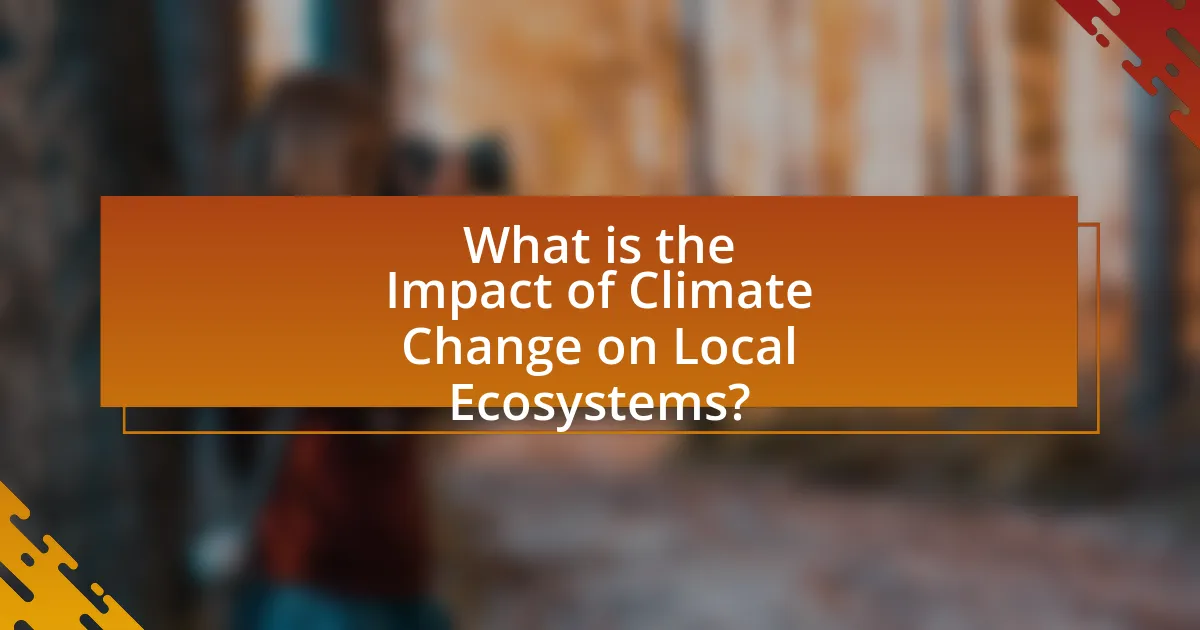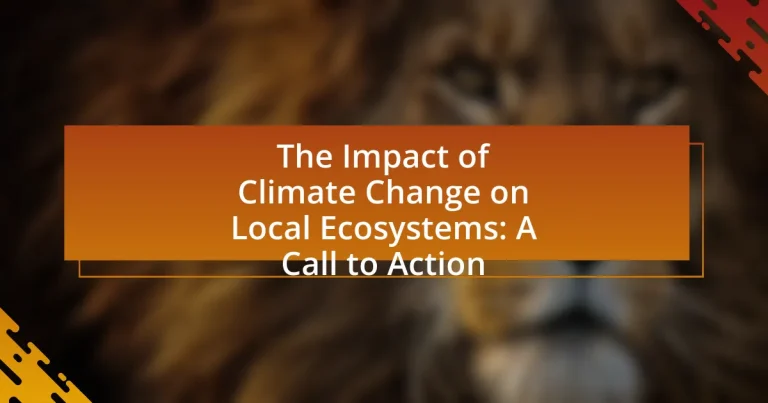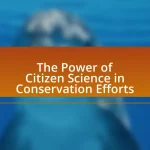The article examines the significant impact of climate change on local ecosystems, highlighting how rising temperatures and altered precipitation patterns disrupt species distributions, food webs, and habitat conditions. It discusses the negative effects on biodiversity, with specific emphasis on vulnerable species such as coral reefs, polar bears, and amphibians. The article also addresses the consequences of climate change on ecosystem services, water quality, and community resilience, while identifying key drivers such as greenhouse gas emissions and land-use changes. Finally, it outlines actionable strategies for mitigation, including habitat restoration, sustainable practices, and community engagement to enhance ecosystem resilience against climate change.

What is the Impact of Climate Change on Local Ecosystems?
Climate change significantly disrupts local ecosystems by altering species distributions, affecting food webs, and changing habitat conditions. For instance, rising temperatures can lead to shifts in plant and animal populations, as species migrate to cooler areas or face extinction if they cannot adapt. A study published in “Nature” by Parmesan and Yohe (2003) found that 50% of species studied showed shifts in their geographic ranges due to climate change. Additionally, changes in precipitation patterns can lead to habitat degradation, impacting biodiversity and ecosystem services. The Intergovernmental Panel on Climate Change (IPCC) reports that these disruptions can result in decreased resilience of ecosystems, making them more vulnerable to invasive species and diseases.
How does climate change affect biodiversity in local ecosystems?
Climate change negatively impacts biodiversity in local ecosystems by altering habitats, disrupting species interactions, and increasing extinction rates. Rising temperatures and changing precipitation patterns lead to habitat loss and fragmentation, making it difficult for many species to survive. For instance, a study published in “Nature” by Bellard et al. (2012) indicates that climate change could cause a significant decline in species richness, with up to 30% of species at risk of extinction by 2050 if current trends continue. Additionally, shifts in climate can result in mismatches between species and their food sources or pollinators, further threatening local biodiversity.
What specific species are most vulnerable to climate change?
Coral reefs, polar bears, and certain amphibians are among the species most vulnerable to climate change. Coral reefs are highly sensitive to temperature changes and ocean acidification, leading to widespread bleaching events. Polar bears rely on sea ice for hunting seals, and the loss of ice due to rising temperatures threatens their survival. Amphibians, such as the golden toad, are particularly susceptible to habitat loss and disease exacerbated by climate change. These species face significant risks due to their specific ecological requirements and the rapid pace of environmental changes.
How do changes in temperature and precipitation impact local flora and fauna?
Changes in temperature and precipitation significantly affect local flora and fauna by altering their growth patterns, reproductive cycles, and habitat availability. For instance, increased temperatures can lead to earlier blooming of plants, which may disrupt the synchronization with pollinators that rely on them, ultimately affecting food availability for herbivores and, consequently, predators. Additionally, altered precipitation patterns can result in droughts or flooding, impacting plant health and leading to shifts in species composition. Research indicates that a 1°C rise in temperature can reduce crop yields by up to 10%, demonstrating the direct impact on local ecosystems. Furthermore, studies show that changes in rainfall can lead to habitat loss for species that depend on specific moisture levels, thereby threatening biodiversity.
What are the observable effects of climate change on ecosystem services?
Climate change has observable effects on ecosystem services, including alterations in biodiversity, water availability, and agricultural productivity. For instance, rising temperatures and changing precipitation patterns lead to shifts in species distributions, which can reduce biodiversity and disrupt food webs. A study by the Intergovernmental Panel on Climate Change (IPCC) indicates that climate change has already caused significant declines in species populations and altered ecosystem functions globally. Additionally, changes in climate affect water resources, with increased evaporation rates and altered rainfall patterns impacting freshwater availability for both ecosystems and human use. Furthermore, agricultural productivity is influenced by climate change, as extreme weather events and shifting climatic conditions can lead to crop failures and reduced yields, threatening food security. These observable effects demonstrate the interconnectedness of climate change and ecosystem services, highlighting the urgent need for action.
How does climate change influence water quality and availability?
Climate change significantly influences water quality and availability by altering precipitation patterns, increasing temperatures, and exacerbating extreme weather events. These changes lead to reduced freshwater availability due to increased evaporation and altered runoff patterns, which can diminish water supplies in many regions. For instance, the National Oceanic and Atmospheric Administration (NOAA) reports that rising temperatures can lead to more intense droughts, reducing surface water levels and impacting groundwater recharge. Additionally, climate change can degrade water quality through increased runoff of pollutants during heavy rainfall events, as well as higher water temperatures that promote harmful algal blooms. According to the U.S. Environmental Protection Agency (EPA), these blooms can produce toxins that contaminate drinking water sources, posing health risks to humans and wildlife.
What role do local ecosystems play in carbon sequestration?
Local ecosystems play a crucial role in carbon sequestration by absorbing and storing carbon dioxide from the atmosphere. Forests, wetlands, and grasslands act as significant carbon sinks; for instance, forests alone store approximately 289 gigatons of carbon globally. This process occurs through photosynthesis, where plants convert carbon dioxide into biomass, effectively reducing atmospheric carbon levels. Additionally, soil in these ecosystems stores carbon in organic matter, further contributing to long-term carbon storage. The preservation and restoration of local ecosystems are essential for enhancing their carbon sequestration capacity, which is vital in mitigating climate change impacts.
Why is it important to address the impact of climate change on local ecosystems?
Addressing the impact of climate change on local ecosystems is crucial because these ecosystems provide essential services that support biodiversity, human health, and economic stability. Climate change disrupts these ecosystems, leading to habitat loss, species extinction, and altered natural processes. For instance, a study published in the journal “Nature” found that climate change could lead to a decline in species diversity by up to 30% by 2050 if no action is taken. Protecting local ecosystems from climate change ensures the preservation of these vital services, which are integral to sustaining life and maintaining ecological balance.
What are the long-term consequences of inaction on local ecosystems?
Inaction on local ecosystems leads to biodiversity loss, habitat degradation, and increased vulnerability to climate change. Over time, species extinction rates can rise significantly; for instance, the International Union for Conservation of Nature reports that approximately 1 million species are currently threatened with extinction due to habitat loss and climate change. Additionally, ecosystems may experience reduced resilience, making them less capable of recovering from disturbances such as natural disasters. This degradation can disrupt ecosystem services, including water purification, pollination, and carbon storage, which are vital for human survival and well-being. Ultimately, the long-term consequences of inaction can result in irreversible damage to ecological balance and a decline in the quality of life for future generations.
How do local ecosystems contribute to community resilience against climate change?
Local ecosystems enhance community resilience against climate change by providing essential services such as carbon sequestration, biodiversity support, and natural disaster mitigation. For instance, wetlands and forests absorb significant amounts of carbon dioxide, helping to reduce greenhouse gas concentrations in the atmosphere. Additionally, diverse ecosystems promote biodiversity, which is crucial for maintaining ecosystem functions and services that communities rely on, such as food production and clean water. Furthermore, ecosystems like mangroves and coastal marshes act as natural barriers against storm surges and flooding, thereby protecting communities from climate-related disasters. Studies show that areas with intact ecosystems experience less severe impacts from climate events, highlighting the importance of preserving these natural systems for community resilience.

What are the key drivers of climate change affecting local ecosystems?
The key drivers of climate change affecting local ecosystems include greenhouse gas emissions, deforestation, and land-use changes. Greenhouse gas emissions, primarily from fossil fuel combustion, contribute to global warming, which alters temperature and precipitation patterns, impacting species distribution and ecosystem health. Deforestation reduces biodiversity and disrupts carbon storage, exacerbating climate change effects. Land-use changes, such as urbanization and agriculture, fragment habitats and alter local climates, further threatening ecosystem stability. These drivers are supported by data indicating that human activities have increased atmospheric CO2 levels by over 40% since the pre-industrial era, leading to significant ecological consequences.
How do human activities contribute to climate change?
Human activities contribute to climate change primarily through the emission of greenhouse gases, such as carbon dioxide and methane. These emissions result from burning fossil fuels for energy, deforestation, and industrial processes. For instance, the burning of coal, oil, and natural gas for electricity and heat accounts for approximately 76% of total greenhouse gas emissions in the United States, according to the Environmental Protection Agency. Additionally, deforestation, which reduces the number of trees that can absorb carbon dioxide, contributes significantly to increased atmospheric CO2 levels. The Intergovernmental Panel on Climate Change reports that human-induced activities have raised global temperatures by about 1.1 degrees Celsius since the late 19th century, leading to severe impacts on ecosystems and weather patterns.
What are the primary sources of greenhouse gas emissions?
The primary sources of greenhouse gas emissions are the burning of fossil fuels, deforestation, and agricultural practices. Fossil fuel combustion for electricity, heat, and transportation accounts for approximately 75% of total greenhouse gas emissions globally. Deforestation contributes significantly by releasing stored carbon dioxide when trees are cut down or burned, while agricultural practices, including livestock production and rice cultivation, emit methane and nitrous oxide, potent greenhouse gases. According to the Intergovernmental Panel on Climate Change (IPCC), these activities collectively drive climate change, impacting local ecosystems and biodiversity.
How does land use change impact local ecosystems?
Land use change significantly impacts local ecosystems by altering habitat availability, species composition, and ecological processes. For instance, deforestation for agriculture reduces biodiversity, as evidenced by a study published in “Nature” by Laurance et al. (2011), which found that tropical deforestation leads to a 50% decline in species richness. Additionally, urbanization disrupts natural water cycles and increases pollution, negatively affecting aquatic ecosystems. Research indicates that land conversion can lead to soil degradation and increased greenhouse gas emissions, further exacerbating climate change effects on local ecosystems.
What natural factors also influence climate change?
Natural factors that influence climate change include volcanic eruptions, solar radiation variations, and ocean currents. Volcanic eruptions release large amounts of ash and sulfur dioxide into the atmosphere, which can lead to temporary cooling by reflecting sunlight. For example, the 1991 eruption of Mount Pinatubo resulted in a global temperature drop of about 0.5 degrees Celsius for two years. Variations in solar radiation, driven by the sun’s natural cycles, can also affect Earth’s climate; periods of increased solar activity correlate with warmer temperatures. Additionally, ocean currents play a crucial role in regulating climate by redistributing heat across the planet, as seen in phenomena like El Niño and La Niña, which can significantly impact weather patterns and temperatures globally.
How do volcanic eruptions and solar radiation affect climate patterns?
Volcanic eruptions and solar radiation significantly influence climate patterns by altering atmospheric composition and energy balance. Volcanic eruptions release large quantities of ash and sulfur dioxide into the atmosphere, which can lead to short-term cooling effects due to the reflection of sunlight. For instance, the 1991 eruption of Mount Pinatubo resulted in a global temperature drop of approximately 0.5 degrees Celsius for about two years. On the other hand, solar radiation variations, such as those associated with the 11-year solar cycle, can affect Earth’s climate by changing the amount of solar energy received. Increased solar activity correlates with warmer temperatures, while decreased activity can lead to cooler periods, as observed during the Maunder Minimum from 1645 to 1715, which coincided with a significant drop in temperatures in Europe. Together, these factors demonstrate how volcanic eruptions and solar radiation can lead to both immediate and long-term changes in climate patterns.
What role do ocean currents play in climate variability?
Ocean currents significantly influence climate variability by redistributing heat across the planet. These currents, such as the Gulf Stream, transport warm water from the equator toward the poles, affecting regional climates and weather patterns. For instance, the Gulf Stream contributes to milder winters in Western Europe compared to North America at similar latitudes. Additionally, changes in ocean currents can lead to phenomena like El Niño and La Niña, which cause widespread climate impacts, including altered precipitation patterns and increased storm activity. Research indicates that disruptions in these currents due to climate change can exacerbate extreme weather events, highlighting their critical role in maintaining climate stability.

What actions can be taken to mitigate the impact of climate change on local ecosystems?
To mitigate the impact of climate change on local ecosystems, implementing conservation strategies such as habitat restoration, sustainable land management, and biodiversity protection is essential. Habitat restoration involves rehabilitating degraded areas to enhance ecosystem resilience, which can be supported by initiatives like reforestation and wetland restoration. Sustainable land management practices, including agroecology and permaculture, reduce environmental degradation and promote soil health, thereby supporting local flora and fauna. Protecting biodiversity through the establishment of protected areas and wildlife corridors helps maintain ecosystem functions and services. According to the Intergovernmental Panel on Climate Change (IPCC), preserving biodiversity is crucial for ecosystem stability and resilience against climate change effects.
How can conservation efforts help local ecosystems adapt to climate change?
Conservation efforts can help local ecosystems adapt to climate change by enhancing biodiversity, restoring habitats, and implementing sustainable land management practices. Biodiversity increases ecosystem resilience, allowing species to better withstand environmental changes. For instance, diverse plant communities can improve soil health and water retention, which are crucial during extreme weather events. Habitat restoration, such as reforestation and wetland rehabilitation, provides critical resources for wildlife and helps maintain ecological balance. Sustainable land management practices, including agroecology and controlled grazing, reduce land degradation and promote carbon sequestration, further mitigating climate impacts. These strategies collectively support ecosystem adaptation, as evidenced by studies showing that restored ecosystems can recover more quickly from climate-related disturbances.
What strategies can be implemented to protect endangered species?
To protect endangered species, strategies such as habitat preservation, legal protection, and community engagement can be implemented. Habitat preservation involves creating and maintaining protected areas to ensure that species have safe environments to thrive. Legal protection includes enforcing laws and regulations that prevent poaching and illegal trade, such as the Endangered Species Act in the United States, which has successfully aided in the recovery of several species. Community engagement fosters local involvement in conservation efforts, leading to sustainable practices that benefit both wildlife and human populations. For instance, the involvement of local communities in the management of natural resources has been shown to enhance biodiversity conservation, as evidenced by successful programs in places like Madagascar, where local stewardship has led to the protection of unique species.
How can habitat restoration contribute to ecosystem resilience?
Habitat restoration enhances ecosystem resilience by re-establishing biodiversity and improving ecosystem functions. Restored habitats can support a wider variety of species, which increases genetic diversity and enhances the ability of ecosystems to adapt to environmental changes. For instance, a study published in the journal “Ecological Applications” found that restored wetlands can significantly improve water quality and provide critical habitat for wildlife, thereby increasing the resilience of the ecosystem to climate change impacts. Additionally, healthy ecosystems are better equipped to withstand disturbances such as floods and droughts, as they can maintain essential services like carbon storage and nutrient cycling.
What role do community initiatives play in addressing climate change?
Community initiatives play a crucial role in addressing climate change by fostering local engagement and implementing sustainable practices. These initiatives empower residents to take collective action, such as organizing tree planting events, promoting recycling programs, and advocating for renewable energy sources. For instance, a study by the Global Environmental Change journal found that community-led projects can reduce carbon emissions by up to 30% in urban areas through localized efforts. Additionally, community initiatives enhance awareness and education about climate issues, leading to more informed decision-making and behavioral changes among residents.
How can local communities engage in sustainable practices?
Local communities can engage in sustainable practices by implementing initiatives such as community gardens, recycling programs, and renewable energy projects. These initiatives promote local food production, reduce waste, and decrease reliance on fossil fuels. For example, community gardens not only provide fresh produce but also enhance biodiversity and strengthen community ties. According to a study published in the Journal of Environmental Management, urban gardening can lead to a 30% increase in local biodiversity. Additionally, recycling programs can significantly reduce landfill waste; the Environmental Protection Agency reports that recycling and composting prevented the release of 186 million metric tons of carbon dioxide equivalent into the air in 2018. By adopting these practices, local communities can effectively contribute to sustainability and mitigate the impacts of climate change on their ecosystems.
What are effective ways to raise awareness about climate change impacts?
Effective ways to raise awareness about climate change impacts include educational campaigns, community engagement, and leveraging social media platforms. Educational campaigns can inform the public about the specific effects of climate change on local ecosystems, such as species extinction and habitat loss, supported by studies indicating that informed communities are more likely to take action. Community engagement initiatives, like local workshops and events, foster direct interaction and discussion, enhancing understanding and commitment to climate action. Social media platforms amplify these messages, reaching wider audiences quickly; for instance, a report by the Pew Research Center shows that 64% of Americans believe social media is an effective tool for raising awareness about social issues, including climate change.
What practical steps can individuals take to support local ecosystems?
Individuals can support local ecosystems by engaging in activities such as planting native species, reducing plastic use, and participating in local conservation efforts. Planting native species helps restore habitats and supports local wildlife, as these plants are adapted to the local environment and provide food and shelter for native animals. Reducing plastic use minimizes pollution, which can harm aquatic and terrestrial ecosystems; for instance, studies show that plastic waste significantly impacts marine life. Participating in local conservation efforts, such as clean-up events or habitat restoration projects, directly contributes to the health of local ecosystems by removing invasive species and restoring natural habitats.


